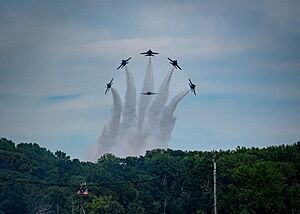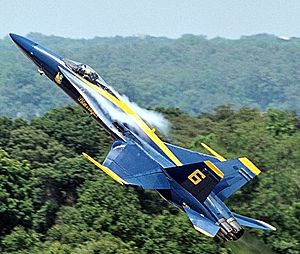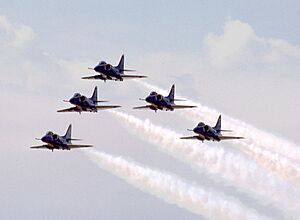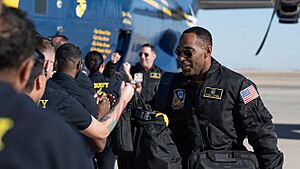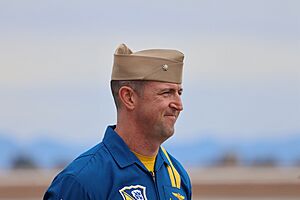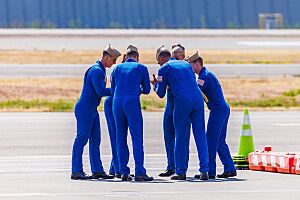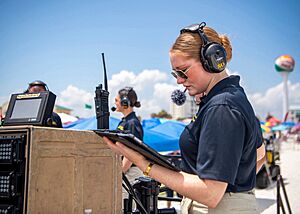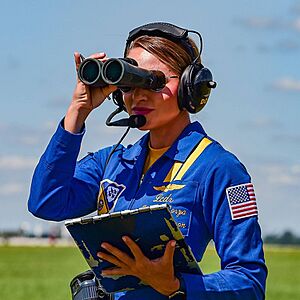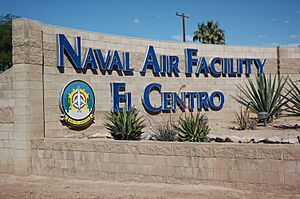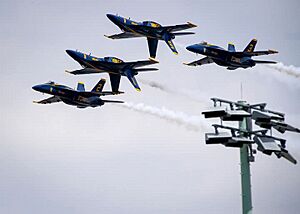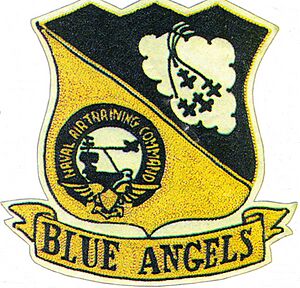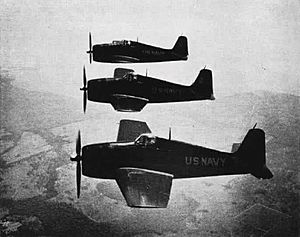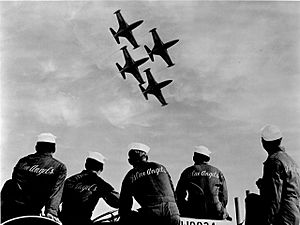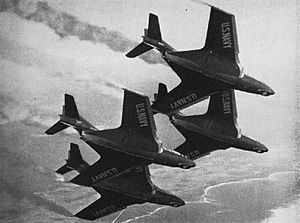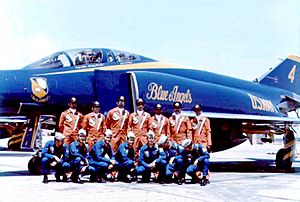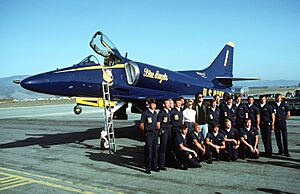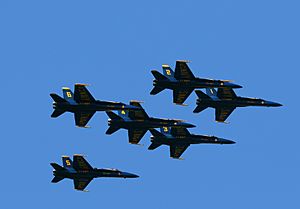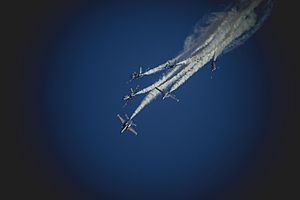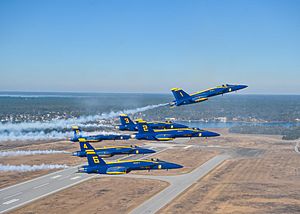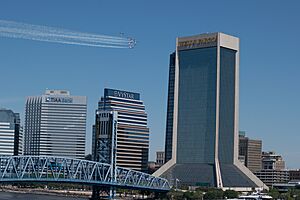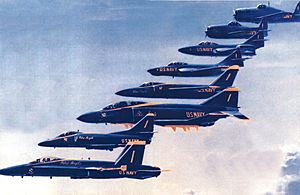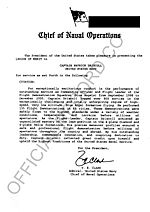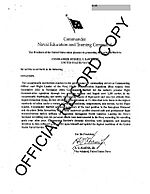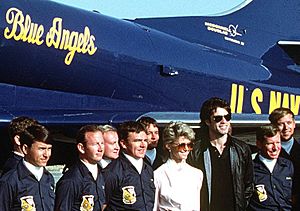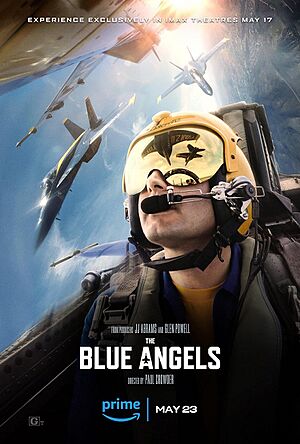Blue Angels facts for kids
Quick facts for kids Blue AngelsU.S. Navy flight demonstration squadron |
|
|---|---|

Blue Angels insignia
|
|
| Active | 24 April 1946–present |
| Country | |
| Branch | United States Navy |
| Role | Aerobatic flight demonstration team |
| Size | Navy: 13 officers Marine Corps: 4 officers Navy & Marine Corps: 100+ enlisted personnel |
| Garrison/HQ | Naval Air Station Pensacola, Florida NAF El Centro, California (Winter Facility) |
| Nickname(s) | The Blues |
| Colors | "Blue Angel" blue "Insignia" yellow |
| Commanders | |
| Current commander |
CDR Adam L. Bryan |
| Aircraft flown | |
| Fighter | Navy: F/A-18E Super Hornets (single seat) (Demonstrations use F/A-18Es #1 to 6; backup is a pair of F/A-18Fs #7) |
| Transport | Marine Corps: 1 C-130J Super Hercules |
The Blue Angels, officially known as the U.S. Navy Flight Demonstration Squadron, are an amazing flight demonstration team of the United States Navy. They were formed in 1946. This makes them the second oldest official aerobatic team in the world. Only the Patrouille de France, formed in 1931, is older. The team has six Navy pilots and one Marine Corps pilot. They fly the Boeing F/A-18E/F Super Hornet and the Lockheed Martin C-130J Super Hercules.
The Blue Angels usually perform at least 60 air shows each year. These shows take place in 32 different locations across the United States and two shows in Canada. The "Blues" still use many of the same flying techniques from their first season in 1946. About 11 million people watch the squadron perform from March through November every year. Blue Angels team members also visit over 50,000 people in schools, hospitals, and community events in the cities where they perform. Since 1946, the Blue Angels have flown for more than 505 million spectators.
Contents
What the Blue Angels Do
The main goal of the Blue Angels is to show the pride and skill of the United States Navy and Marine Corps. They do this by inspiring people to aim for excellence and serve their country. They achieve this through their amazing flight shows and by connecting with communities.
Air Shows and Maneuvers
The Blue Angels perform at both military and civilian airfields. They often visit major U.S. cities and capitals. Canadian locations are also frequently part of their schedule. Six jets perform in an air show: the Diamond (pilots 1 through 4) and the Solos (pilots 5 and 6).
How They Fly Their Shows
The Diamond formation starts with a special takeoff. Then they perform maneuvers like the Diamond 360 and Diamond Roll. The Solos perform their own exciting takeoffs and opposing maneuvers. These include the Knife Edge Pass and Inverted to Inverted flights. They also show off the Super Hornet's turning ability with the Solo Minimum Radius Turn. Both Solos perform opposing maneuvers like the Opposing Horizontal Rolls. They also do sneak passes and vertical pitches.
After their solo routines, the Solos join the Diamond formation for five Delta Maneuvers. These include the Delta Roll and Fleur De Lis. The show ends with the Delta Pitch Up Break to Landing.
The type of show they perform depends on the weather.
- The High Show is for clear weather. It needs at least 8,000 feet of cloud-free space above and good visibility.
- The Low Show is for cloudy conditions.
- The Flat Show is for limited visibility.
The minimum cloud height for low shows is 4,500 feet, and for flat shows, it is 1,500 feet.
Aircraft They Fly
Current Aircraft
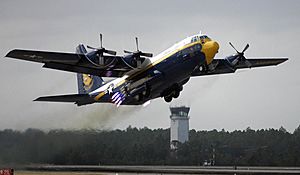
The team flew the McDonnell Douglas F/A-18 Hornet for 34 years, from 1986 to 2020. The team now flies the Boeing F/A-18 Super Hornet.
In 2018, Boeing received a contract to change nine single-seat F/A-18E Super Hornets and two F/A-18F two-seaters for the Blue Angels. These changes include removing weapons and adding a tank for smoke-oil used in demonstrations. The control stick also gets a special spring system for more precise control. Each modified F/A-18 can still be used for combat if needed. The team started using these Super Hornets for testing in mid-2020. They became fully operational by early 2021, which was their 75th anniversary year.
The show's narrator, Blue Angels No. 8, flies a two-seat F/A-18F Super Hornet. This jet is used as a backup or for special rides for VIPs (very important people). Two back-seat rides are usually available at each air show. One goes to a member of the press, and the other to a "Key Influencer." The No. 4 Slot Pilot often flies the No. 7 aircraft during Friday practices. This allows other pilots to experience the show.
In 2020, the United States Marine Corps Blue Angels bought a Lockheed C-130J Super Hercules from the Royal Air Force. This plane is the new "Fat Albert." It carries spare parts, equipment, and support staff between shows.
Historical Aircraft
F6F-5 Hellcat
The Hellcat was the first aircraft flown by the team. Pilots were advanced flight instructors who had flown these planes in war. The F6F-5s were dark navy blue with gold letters. They made their first flight demonstration on May 10, 1946.
F8F-1 Bearcat
The Bearcat started flying near the end of the team's first season. It was the last propeller-driven plane the Blue Angels used. It was also the first to fly the famous diamond formation. The Bearcats first appeared in Denver in August 1946.
F9F-2 Panther
The Panther was the first jet used by the Blue Angels. After a break for the Korean War, the F9F-5 Panther was used again when the team restarted on October 25, 1951.
F9F-8 Cougar
In the winter of 1954-1955, the Cougar began to be flown by the Blue Angels. It was used until mid-1957.
F11F-1 Tiger
In mid-1957, the Tiger started flying with the Blue Angels. The F11F-1 was their first supersonic jet. It was also the last Grumman plane to serve the team. It was used until 1969. This plane was very popular with the public because of its afterburner and sleek design.
F-4J Phantom II
In 1969, the F-4J became the demonstration plane. It was used until December 1974. The F-4 was flown by both the Blue Angels and the Thunderbirds demonstration teams at the same time.
A-4F Skyhawk II
Due to some incidents and fuel costs, the team switched to the more fuel-efficient A-4F Skyhawk II. The Blue Angels flew the A-4 in 80 shows during the 1976 Bicentennial celebrations. In 1976, the Blue Angels also celebrated 30 years and performed their 2,000th show flying the A-4F. The Skyhawk was used from December 1974 to November 1986.
F/A-18 Hornet
In 1986, the Blue Angels changed to the F/A-18 Hornet. The F/A-18A model was used from 1986 to 2010. The F/A-18C model was used from 2010 to 2020.
F/A-18 Super Hornet
The Blue Angels are currently in their fifth year of flying the Boeing F/A-18 Super Hornet. They use the F/A-18E model for demonstrations. The F/A-18F is used for Blue Angel #7 and for the #4 Slot Pilot's practice routines.
Team Members
2025 United States Navy Blue Angels Demonstration Pilots and Flight Officers
- 1. CDR Adam "Gilligan" Bryan: Flight Leader / Commanding Officer
- 2. CDR Jack "Rico" Keilty: Right Wing
- 3. MAJ Brandon "Wobbly" Wilkins: Left Wing
- 4. LCDR Wes "Trash" Perkins: Slot
- 5. CDR Thomas "Franz" Zimmerman: Lead Solo
- 6. LCDR Connor "Buddy" O Donnell: Opposing Solo
- 7. MAJ Scott "Goldie" Laux: Narrator
- 8. LCDR Lilly Montana: Events Coordinator
Since the team started, there have been 272 demonstration pilots in the Blue Angels.
The team has three main groups: Officers, Enlisted, and Technical Representatives. All team members come from the regular United States Navy and United States Marine Corps units. The demonstration pilots and narrator are Navy and USMC Naval Aviators. Pilots serve for two to three years. Their roles depend on team needs, pilot experience, and career plans. Other officers include an events coordinator, three USMC C-130 pilots, and officers for maintenance, medical, supply, public affairs, and administration. Enlisted members handle all maintenance, office work, and support. They serve three to four years. After their time with the squadron, members return to other Navy or Marine Corps jobs.
To become a Blue Angel, pilots and support officers must apply formally. They need a personal statement, recommendation letters, and flight records. Navy and Marine Corps F/A-18 pilots need at least 1,250 hours flying tactical jets and must be qualified to land on aircraft carriers. Marine Corps C-130 pilots need 1,200 flight hours and must be aircraft commanders.
Applicants visit the team at airshows, paying their own way. They attend team meetings and social events. It is important that new officers fit well with the team's culture. The application process runs from March to early July. It ends with interviews and team discussions. Team members vote secretly on the next year's officers. All votes must be in agreement.
The Flight Leader (No. 1) is the Commanding Officer. This person always holds the rank of commander. They may be promoted to captain during their time if approved.
Current Flight Leader/Commanding Officer Commander Adam L. Bryan from Canton, Connecticut became the Blue Angels' commander in November 2024. He took over from Captain Alexander P. Armatas.
Pilots numbered 2–7 are Navy Lieutenant Commanders or Lieutenants, or Marine Corps Majors or Captains. The #7 pilot narrates for one year. Then they usually fly Opposing Solo (#6) and then Lead Solo (#5) for the next two years. The #3 pilot moves to the #4 "Slot" position for their second year. Blue Angel #4 is the safety officer. This is because of their view from the slot position and their experience as a second-year pilot. #8 serves as the Events Coordinator for two years. This job involves managing VIPs, media, and special guest rides. They also ensure each event and airshow is successful.
Since 2008, six female flight officers have been chosen. LCDR Amanda Lee was the first woman to be a F/A-18 demonstration pilot. She served from 2022 to 2024. LCDR Lilly Montana is the Events Coordinator for the 2025 season. MAJ Katie Higgins Cook USMC served as a C-130 pilot.
Several minority flight officers have served. CAPT Donnie Cochran was the first African American to command the Blue Angels.
One Navy Pilot serves two years as the Maintenance Officer. This officer is in charge of the people and equipment that keep the aircraft flying. At airshows, they monitor weather conditions and the performance of the pilots.
Flight surgeons (DOC) serve for two years. The flight surgeon provides medical care for the team. They also watch the demonstrations from the ground for safety.
The Public Affairs Officer handles all media, videos, and social media for the Blue Angels. They also communicate with the public for questions and interviews.
Enlisted Personnel
The Blue Angels have almost 100 enlisted personnel from the Navy and Marine Corps. About 50 personnel attend each show. They ensure all operations run smoothly. This includes jet maintenance, transportation between shows, event management, and hotels for the team. Enlisted volunteers serve a three-year tour with the squadron. Departments include FAT ALBERT MAINTENANCE, Crew Coordinators, Airframes, Avionics, Crew Chiefs, and more.
All enlisted personnel are dedicated and skilled. They make it possible for the Blue Angels to fly every day and everywhere.
Training and Weekly Routine
Annual winter training happens at NAF El Centro, California. Here, new and returning pilots improve their skills. During winter training, pilots fly two practice sessions daily, six days a week. They complete 120 training missions to perform safely. The distance between aircraft and their flying height is slowly reduced over two months. The team then returns to their home base in Pensacola, Florida, in March. They continue to practice throughout the show season.
A typical week during the season includes practices at NAS Pensacola on Tuesday and Wednesday mornings. The team then flies to their show location on Thursday. They do "circle and arrival" maneuvers to get familiar with the area. On Friday, they fly a "practice" airshow. This show is often open to the public. The main airshows are on Saturdays and Sundays. The team returns home to NAS Pensacola on Sunday evenings. Monday is a day off for the pilots and road crew. Extensive aircraft maintenance is done on Sunday evening and Monday.
Pilots hold the flight stick with their right hand and operate the throttle with their left. They wear gloves to prevent sweaty hands. They do not wear G-suits. These suits inflate and deflate, which could cause unwanted movements. To make up for not wearing G-suits, Blue Angel pilots tense their muscles. This helps prevent blood from pooling in their legs, which could make them pass out.
History of the Blue Angels
How It Started
The Blue Angels were first formed in April 1946. They were called the Navy Flight Exhibition Team. They changed their name to the Blue Angels after seeing an advertisement for a New York nightclub called "The Blue Angel." The team was first introduced as the Blue Angels at an air show in July 1946.
The first Blue Angels planes were dark navy blue with gold letters. The current blue and yellow colors were adopted in August 1946. This was when they switched from the Grumman F6F-5 Hellcat to the Grumman F8F-1 Bearcat. In 1949, the planes were all yellow with blue markings.
The original Blue Angels insignia was designed in 1949. The aircraft shapes on the insignia change as the team changes planes.
The Blue Angels switched from propeller planes to blue and gold jet aircraft (Grumman F9F-2B Panther) in August 1949.
In 1952, the Blue Angels started wearing leather jackets and special colored flight suits with their insignia. In 1953, they began wearing gold flight suits for the first show of the season or to celebrate special events.
The Navy Flight Exhibition Team was officially renamed the United States Navy Flight Demonstration Squadron on December 10, 1973.
Early Years (1946–1949)
The Blue Angels were created on April 24, 1946. This was ordered by Chief of Naval Operations Admiral Chester Nimitz. The goal was to gain public support for naval aviation. Lieutenant Commander Roy Marlin Voris, a World War II fighter ace, was chosen to lead the team. Voris picked three other instructors to join him. They practiced their maneuvers in secret over the Florida Everglades. The first pilots were some of the Navy's best and most experienced aviators.
The team's first demonstration was on May 10, 1946, with Grumman F6F-5 Hellcat aircraft. It was a great success. Their first public air show was on June 15, 1946, in Jacksonville, Florida. Voris led three Hellcats, specially painted blue with gold trim. They performed for 15 minutes. The team also used a North American T-6 Texan painted to look like a Japanese Zero. This plane was later painted yellow and called the "Beetle Bomb."
The team impressed crowds with low-flying maneuvers in tight formations. At an air show in Omaha, Nebraska in July 1946, the team was introduced as the Blue Angels. The name came from a suggestion by pilot Lt. Maurice "Wick" Wickendoll. He had read about the Blue Angel nightclub in The New Yorker magazine. After ten shows with the Hellcats, they switched to the faster F8F-1 Bearcats on August 25. By the end of the year, the team had four Bearcats.
In May 1947, Lt. Cmdr. Bob Clarke became the new team leader. The team moved to Naval Air Station (NAS) Corpus Christi, Texas. On June 7, in Birmingham, Alabama, four F8F-1 Bearcats flew in a diamond formation for the first time. This is now the Blue Angels' famous trademark. A fifth Bearcat was added that year.
In 1949, the team got a Douglas R4D Skytrain for logistics. The "Beetle Bomb" was replaced by another Bearcat, painted yellow for air combat. In May, the team went to the west coast to learn about jet aircraft. On July 13, they started flying the Grumman F9F-2B Panther jets. On August 20, the team debuted the Panther jets at an air show in Beaumont, Texas. They also added a sixth pilot. The F8F-1 "Beetle Bomb" was then used for solo aerobatics before the main show.
1950s Highlights
The Blue Angels continued to perform in 1950. On June 25, the Korean War began. All Blue Angels pilots volunteered for combat duty. The squadron was temporarily disbanded. Its members were sent to combat.
On October 25, 1951, the Blues were ordered to restart as a flight demonstration team. They reported to NAS Corpus Christi, Texas. Lt. Cdr. Voris was again asked to put the team together. In May 1952, the Blue Angels began performing again with F9F-5 Panthers. In 1953, the team traded its Sky Train for a Curtiss R5C Commando. After summer, the team began demonstrating with the F9F-6 Cougar.
In 1954, the first Marine Corps pilot, Captain Chuck Hiett, joined the team. The Blue Angels also received special colored flight suits. In May, the Blue Angels performed in Washington, D.C., with the Air Force Thunderbirds. The Blue Angels moved to their current home at Naval Air Station (NAS) Pensacola, Florida, that winter. There, they switched to the swept-wing Grumman F9F-8 Cougar. In December, the team went to its first winter training facility at Naval Air Facility El Centro, California.
In September 1956, the team added a sixth aircraft to the flight demonstration. This was for the Opposing Solo position. They also performed outside the United States for the first time in Toronto, Canada. They also upgraded their logistics aircraft to the Douglas R5D Skymaster.
In 1957, the Blue Angels switched from the F9F-8 Cougar to the supersonic Grumman F11F-1 Tiger. The first demonstration with the Tiger was on March 23. The demonstration team wore gold flight suits during the first air show that season.
In 1958, the first Six-Plane Delta Maneuvers were added to the show.
1960s and 1970s
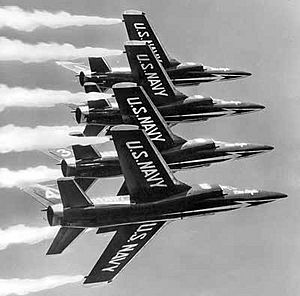
In July 1964, the Blue Angels performed in Mexico City, Mexico. An estimated 1.5 million people watched.
In 1965, the Blue Angels toured the Caribbean islands. Later that year, they went on a European tour. They performed at the Paris Air Show, where they received a standing ovation.
In 1968, the C-54 Skymaster transport aircraft was replaced with a Lockheed VC-121J Constellation. The Blues switched to the two-seat McDonnell Douglas F-4J Phantom II in 1969. The Phantom was the only plane flown by both the "Blues" and the United States Air Force Thunderbirds (the "Birds"). That year, they also upgraded to the Lockheed C-121 Super Constellation for logistics.
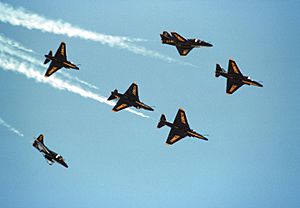
In 1970, the Blues received their first U.S. Marine Corps Lockheed KC-130F Hercules. This plane was flown by an all-Marine crew. That year, they went on their first South American tour.
In 1971, the team went on its first Far East Tour. They performed in Korea, Japan, Taiwan, Guam, and the Philippines.
In 1973, another European tour followed. This included air shows in Iran, England, France, Spain, Turkey, Greece, and Italy.
On December 10, 1973, the Navy Flight Exhibition Team was officially renamed the United States Navy Flight Demonstration Squadron. The Blues' mission became more focused on Navy recruiting.
In 1974, the Blue Angels switched to the new Douglas A-4F Skyhawk II. Navy Commander Anthony Less became the squadron's first "commanding officer" and "flight leader." A permanent flight surgeon and administration officer were added to the team.
Starting in 1975, "Bert" (the C-130) was used for Jet Assisted Take Off (JATO) and short aerial demonstrations. The JATO demonstration ended in 2009. "Fat Albert Airlines" is flown by an all-Marine crew.
1980s and 1990s
In 1986, LCDR Donnie Cochran joined the Blue Angels. He was the first African-American Naval Aviator chosen for the team. He later returned to command the Blue Angels in 1995 and 1996.
On November 8, 1986, the Blue Angels celebrated their 40th anniversary. They also introduced their new aircraft, the McDonnell Douglas F/A-18 Hornet. The Hornet's power allows them to perform a slow, high-angle "tail sitting" maneuver. They can also fly a "dirty" (landing gear down) formation loop.
In 1992, the Blue Angels went on a month-long European tour. This was their first in 19 years. They performed in Sweden, Finland, Russia (the first foreign flight demonstration team to perform there), Romania, Bulgaria, Italy, the United Kingdom, and Spain.
In November 1998, CDR Patrick Driscoll made the first "Blue Jet" landing on an aircraft carrier, USS Harry S. Truman.
2000s and 2010s
In 2000, the Navy investigated an incident from October 1999. The pilots of the F/A-18 Hornet were not required to wear g-suits.
On April 21, 2007, pilot Kevin "Kojak" Davis was lost when his jet crashed during an air show in Beaufort, South Carolina.
The Fat Albert performed its final JATO demonstration at the 2009 Pensacola Homecoming show. This was the last JATO use for the U.S. Marine Corps.
In 2009, the Blue Angels were added to the International Air & Space Hall of Fame.
On May 22, 2011, the Blue Angels were performing in Lynchburg, Virginia. The Diamond formation flew a maneuver lower than required. The maneuver was stopped, and the rest of the show was canceled. All aircraft landed safely. The next day, the Blue Angels announced a safety stand-down. They canceled upcoming shows to return to Pensacola, Florida, for more training.
On May 27, 2011, Commander Dave Koss, the squadron's commanding officer, stepped down. He was replaced by Captain Greg McWherter, the team's previous commander. The squadron canceled more performances to allow for additional practice.
On July 29, 2011, a new Blue Angels Mustang GT was auctioned for $400,000. This happened at the Experimental Aircraft Association AirVenture Oshkosh air show.
Between September 2 and 4, 2011, the Blue Angels flew for the first time using a blend of jet fuel and a plant-based biofuel.
On March 1, 2013, the U.S. Navy announced that it was canceling remaining 2013 performances after April 1. This was due to budget cuts. In October 2013, the Secretary of Defense announced that the Blue Angels would resume air shows in 2014.
On March 15, 2014, the demonstration pilots wore gold flight suits. This celebrated the team's "return to the skies" during their first air show of the season.
In July 2014, Marine Corps C-130 pilot Capt. Katie Higgins became the first female pilot to join the Blue Angels. She flew the support aircraft Fat Albert for the 2015 and 2016 show seasons.
In July 2015, Cmdr. Bob Flynn became the Blue Angels' first executive officer.
On June 2, 2016, Capt. Jeff Kuss, an Opposing Solo, was lost during a practice run in Smyrna, Tennessee.
In July 2016, Boeing received a contract to begin planning for converting the Boeing F/A-18E/F Super Hornet for Blue Angels use.
The Fat Albert (BUNO 164763) was retired in May 2019 after 30,000 flight hours. The Blue Angels replaced it with a C-130J Super Hercules from the Royal Air Force.
Recent Years (2020–present)
In response to the COVID-19 pandemic, the Blue Angels flew over many U.S. cities. These flights were a tribute to healthcare and front-line workers.
The Blues officially switched to Boeing F/A-18E/F Super Hornets on November 4, 2020.
In July 2022, Lt. Amanda Lee was announced as the first woman to serve as a demonstration pilot in the Blue Angels.
Aircraft Timeline
The "Blues" have flown ten different demonstration aircraft and six support aircraft models:
Demonstration aircraft
- Grumman F6F-5 Hellcat: June – August 1946
- Grumman F8F-1 Bearcat: August 1946 – 1949
- Grumman F9F-2 Panther: 1949 – June 1950 (first jet); F9F-5 Panther: 1951 – Winter 1954/55
- Grumman F9F-8 Cougar: Winter 1954/55 – mid-season 1957 (swept-wing)
- Grumman F11F-1 (F-11) Tiger: mid-season 1957 – 1968 (first supersonic jet)
- McDonnell Douglas F-4J Phantom II: 1969 – December 1974
- Douglas A-4F Skyhawk: December 1974 – November 1986
- McDonnell Douglas F/A-18 Hornet (F/A-18B as #7): November 1986 – 2010
- Boeing F/A-18A/C (B/D as #7) Hornet: 2010-2020
- Boeing F/A-18E Super Hornet (F/A-18F as #7): 2020–
Support aircraft
- JRB Expeditor (Beech 18): 1949–?
- Douglas R4D-6 Skytrain: 1949–1955
- Curtiss R5C Commando: 1953
- Douglas R5D Skymaster: 1956–1968
- Lockheed C-121 Super Constellation: 1969–1973
- Lockheed C-130 Hercules "Fat Albert": 1970–2019
- Lockheed Martin C-130J Super Hercules "Fat Albert": 2020–present
Other aircraft
- North American SNJ Texan "Beetle Bomb" (used to pretend to be a Japanese A6M Zero in shows during the late 1940s)
- Lockheed T-33 Shooting Star (Used in the 1950s as a VIP transport)
- Vought F7U Cutlass (two were used for a side demonstration in 1953 but were not part of the main team)
Commanding Officers
Some notable Commanding Officers include:
- Roy Marlin Voris – 1946, 1952
- John J. Magda – 1950
- Arthur Ray Hawkins – 1952 to 1953
- Richard Cormier – 1954 to 1956
- Edward B. Holley – 1957 to 1958
- Zebulon V. Knott – 1959 to 1961
- Kenneth R. Wallace – 1962 to 1963
- Robert F. Aumack – 1964 to 1966
- William V. Wheat – 1967 to 1969
- Harley H. Hall – 1970 to 1971
- Don Bently – 1972
- Marvin F. "Skip" Umstead – 1973
- Anthony A. Less – Oct 1973 to Jan 1976
- Keith S. Jones – 1976 to 1978
- William E. Newman – 1978 to 1979
- Hugh D. Wisely – Dec 1979 to 1982
- David Carroll – 1982 to 1983
- Larry Pearson – 1983 to 1985
- Gilman E. Rud – Nov 1985 to Nov 1988
- Patrick D. Moneymaker – Nov 1988 to Nov 1990
- Gregory C. Wooldridge – Nov 1990 to 1993, 1996
- Robert E. Stumpf – 1993 to 1994
- Donnie Cochran – Nov 1994 to May 1996
- George B. Dom – Nov 1996 to Oct 1998
- Patrick Driscoll – Oct 1998 to 2000
- Robert A. Field – 2000 to Sept 2002
- Russell J. Bartlett – Sept 2002 to Sept 2004
- Stephen R. Foley – Sept 2004 to Nov 2006
- Kevin Mannix – Nov 2006 to 2008
- Gregory McWherter 2008 to 2010, 2011
- David Koss – Fall 2010 to spring 2011
- Gregory McWherter – 2011 to 2012
- Thomas Frosch – 2012 to 2015
- Ryan Bernacchi – 2015 to 2017
- Eric D. Doyle – 2017 to 2019
- Brian C. Kesselring – 2019 to 2022
- Alexander P. Armatas – 2022 to 2024
- Adam Bryan – 2024 to present
Notable Team Members
Here are some of the well-known members of the Blue Angels squadron:
- Capt Roy "Butch" Voris, World War II fighter ace and first Flight Leader
- Charles "Chuck" Brady Jr., Astronaut and physician
- Donnie Cochran, First African-American Blue Angels aviator and commander
- Edward L. Feightner, World War II fighter ace and Lead Solo
- Arthur Ray Hawkins, World War II flying ace
- Bob Hoover, World War II fighter pilot and flight instructor, honorary Blue Angel member
- Anthony A. Less, First Commanding Officer of Blue Angels squadron
- Robert L. Rasmussen, aviation artist
- Raleigh Rhodes, World War II and Korean War fighter pilot and third Flight Leader
- Patrick M. Walsh, Left Wingman and Slot Pilot who later held high commands
- Katie Higgins Cook, First female Blue Angels pilot
- Amanda Lee, First female Blue Angels demonstration pilot
Team Incidents
Flying high-speed, close-formation aerobatics is very challenging. Over the years, some Blue Angels pilots have been lost during their service.
Pilots Lost During Service
- Lt. Ross "Robby" Robinson – September 29, 1946: lost during a performance.
- Lt. Bud Wood – July 7, 1952: lost when his jet collided with another during a demonstration.
- Cmdr. Robert Nicholls Glasgow – October 14, 1958: lost during an orientation flight.
- Lt. Anton M. Campanella – June 14, 1960: lost during a test flight.
- Lt. George L. Neale – March 15, 1964: lost during an attempted emergency landing.
- Lt. Cmdr. Dick Oliver – September 2, 1966: lost during a show in Toronto.
- Lt Frank Gallagher – February 1, 1967: lost during a practice maneuver.
- Capt. Ronald Thompson – February 18, 1967: lost during a practice formation loop.
- Lt. Bill Worley – January 14, 1968: lost during a practice maneuver.
- Lt. Larry Watters – February 14, 1972: lost during winter training.
- Lt. Cmdr. Skip Umstead, Capt. Mike Murphy, and ADJ1 Ron Thomas – July 26, 1973: all three were lost in a mid-air collision during a practice. The rest of the season was canceled.
- Lt. Nile Kraft – February 22, 1977: lost during practice.
- Lt. Michael Curtin – November 8, 1978: lost during arrival maneuvers.
- Lt. Cmdr. Stu Powrie – February 22, 1982: lost during winter training.
- Lt. Cmdr. Mike Gershon – July 13, 1985: lost in a mid-air collision during a show.
- Lt. Cmdr. Kieron O'Connor and Lt. Kevin Colling – October 28, 1999: both lost during practice maneuvers.
- Lt. Cmdr. Kevin J. Davis – April 21, 2007: lost during an airshow.
- Capt. Jeff Kuss – June 2, 2016: lost during a practice run.
Other Flight Incidents
- Lt. John R. Dewenter – August 2, 1958: landed his jet without landing gear after engine trouble. He was uninjured.
- Lt. Ernie Christensen – August 30, 1970: landed his jet on its belly after forgetting to lower the landing gear. He was safe.
- Cmdr. Harley Hall – June 4, 1971: safely exited his jet after it caught fire during practice.
- Capt. John Fogg, Lt. Marlin Wiita, and Lt. Cmdr. Don Bently – March 8, 1973: all three survived a mid-air collision during practice.
- Lt. Jim Ross – April 1980: unhurt when his jet had a fuel line fire during a show. He landed the plane safely.
- Lt. Dave Anderson – February 12, 1987: exited his jet after both engines stopped during practice.
- Marine Corps Maj. Charles Moseley and Cmdr. Pat Moneymaker – January 23, 1990: their jets collided during a practice. Moseley exited safely, and Moneymaker landed his plane.
- Lt. Ted Steelman – December 1, 2004: exited his jet after it hit the water. He had minor injuries.
Former Blue Angels Pilots Lost in Combat
Four former Blue Angels pilots were lost in combat after their time with the team.
Korean War
- Commander John Magda – March 8, 1951: Lost when his jet was hit by anti-aircraft fire during a mission in the Korean War.
Vietnam War
- Commander Herbert P. Hunter – July 19, 1967: Lost when his jet was hit by anti-aircraft fire in North Vietnam.
- Captain Clarence O. Tolbert – November 6, 1972: Lost when his jet was hit by anti-aircraft fire during a mission in North Vietnam.
- Captain Harley H. Hall – January 27, 1973: Lost when his jet was shot down in South Vietnam on the last day of the Vietnam War. His remains were identified in 1994.
Blue Angels in Media
- The Blue Angels was a TV series from 1960 to 1961. It was inspired by the team and made with the Navy's help.
- Threshold: The Blue Angels Experience is a 1975 documentary film. It shows the team practicing and performing.
- To Fly!, a short IMAX film, features footage from a camera on a Blue Angels plane.
- In 1981, the Blue Angels were featured on a Laserdisc in Japan called Blue Angels/Thunderbirds.
- The Blue Angels were in the 1986 music video for "Dreams" by Van Halen.
- In 1987, the Blue Angels were featured in Rolling in the Sky: F/A-18 Blue Angels.
- In 1996, the Blue Angels appeared in the IMAX short film The Magic of Flight.
- In 2005, the Discovery Channel aired a documentary series, Blue Angels: A Year in the Life. It showed the team's daily training and performance schedule.
- In 2024, the Blue Angels appeared in the IMAX feature film The Blue Angels. This film shows the team's 2022 training and show seasons.
See also
 In Spanish: Blue Angels para niños
In Spanish: Blue Angels para niños
- List of United States Navy aircraft squadrons
- United States Air Force Thunderbirds
- United States Marine Corps Aviation


